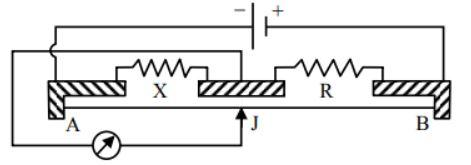Question
Question: The figure shows a metre- bridge circuit, with \(AB = 100\,cm\), \(X = 12\,\Omega \) and \(R = 18\,\...
The figure shows a metre- bridge circuit, with AB=100cm, X=12Ω and R=18Ω , and the jockey J in the position of balance. If R is now made 8Ω , through what distance will J have to be moved to obtain in balance?

(A) 10cm
(B) 20cm
(C) 30cm
(D) 40cm
Solution
Metre bridge is mainly used for the finding of the unknown resistance connected in the circuit. It uses the formula of the ratio of the known and the unknown resistance is equal to the ratio of the balancing length of the metre bridge. The difference of both lengths provides the value of the distance to be moved by a jockey.
Formula used:
In the meter bridge,
RX=100−ll
Where XandR are the value of the resistance in the meter bridge circuit, l is the length of the circuit.
Complete step by step answer:
Given: Value of the resistance, X=12Ω
Value of the other resistance, R=18Ω
The length of the meter bridge circuit, AB=100cm
Final value of the resistance, R′=8Ω
Using the formula of the metre bridge for the initial condition as
RX=100−ll
Substituting the value of the known parameters in the above formula,
1812=100−ll
By cross multiplying the terms in both left hand side and the right hand side of the equation,
6(100−l)=18l
600=12l
By further simplification,
l=50cm
By substituting the final condition in the formula,
812=100−l′l′
By further simplification of the above equation, we get
l′=30cm
The distance that the jockey is moved is calculated by the difference of the length of the circuit.
l−l′=50−30=20cm
Hence, the correct answer is option (B).
Note: Metre Bridge works on the principle of the Wheatstone bridge and it is used for the purpose of the unknown resistance that is connected in the circuit by adjusting the jockey in between the resistors by using the balancing length.
